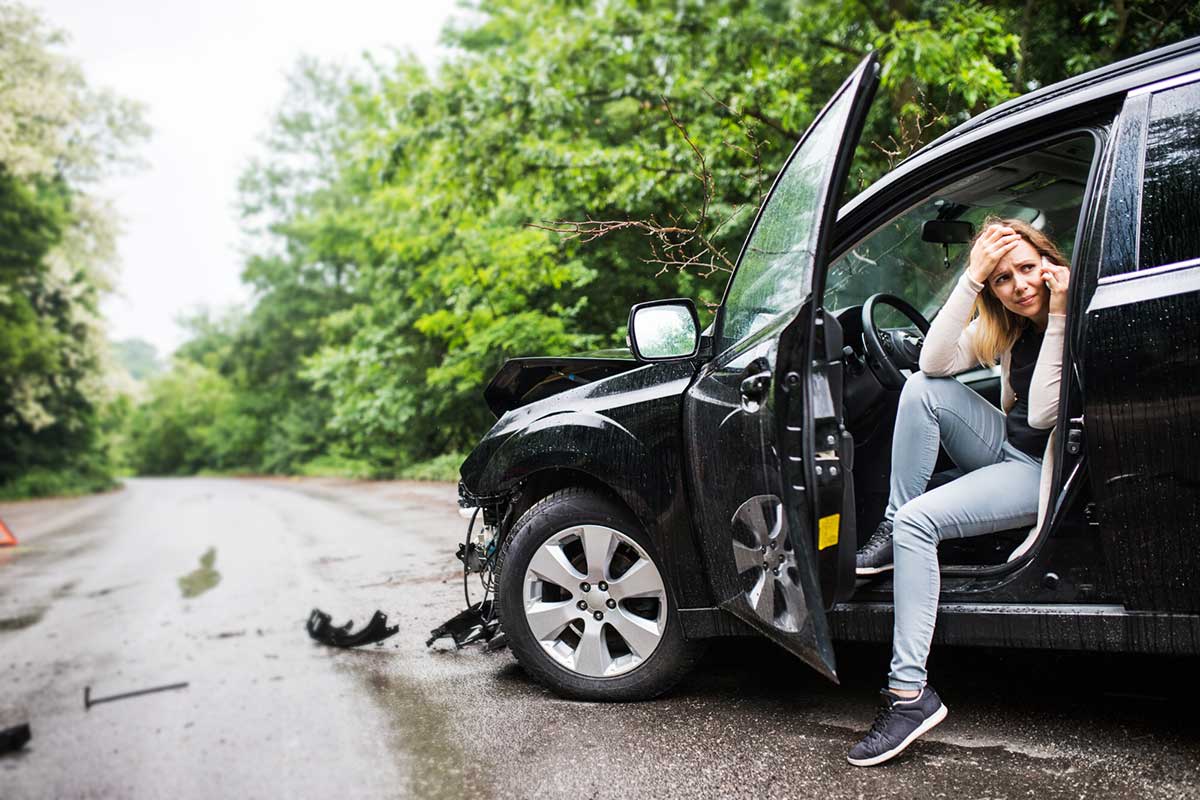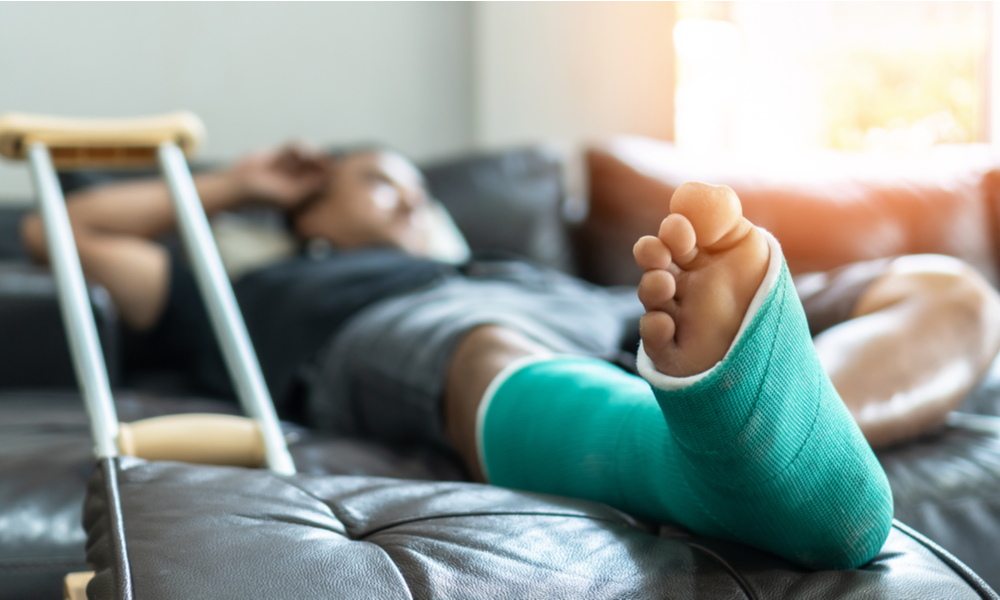
Nobody expects to be injured in a car accident, but when it happens, you need reliable information fast. Whether you have visible injuries or just symptoms that concern you, understanding your next steps and your rights to fair compensation can help you recover physically, mentally, and financially.
Here’s your complete guide to navigating car accident injuries in Massachusetts.
Car Accident Injuries Statistics & Facts
Car accident injuries remain a significant concern in Massachusetts:
- As of June 2024, there have been 14,119 minor injury car accidents reported in Massachusetts.
- Serious injury crashes totaled 2,421 in 2023. As of June 2024, there have been 1,720 serious injury crashes.
- According to Massachusetts public health data, 35% of hospitalized car and truck drivers tested positive for alcohol or drugs at the time of their crashes.
What Is an Auto Accident Injury?
An auto accident injury covers any harm, whether physical, emotional, or psychological, that a driver and/or passengers experience after a car crash. Injuries, such as head trauma, often need immediate medical attention, and many people seek legal help to ensure they get compensation for medical bills, as well as lost wages and other damages caused by the accident.
Common Types of Car Accident Injuries
Car crashes can lead to a wide range of injuries. These injuries fall into several categories, and in every case, you may be entitled to financial recovery:
- Brain and head injuries: Brain and head injuries can cause symptoms like headaches, dizziness, or confusion, and they call for medical attention.
- Spine and neck injuries: People often feel stiff, numb, or experience sharp pain. Quick imaging tests are usually needed.
- Torso and back injuries: Symptoms include back pain, breathing difficulty, and abdominal tenderness. Early care involves imaging, pain management, and surgery in severe cases.
- Joint and limb injuries: Signs include swelling, bruises, and trouble moving. Early treatment involves ice and stabilization.
- Soft tissue injuries: Wounds like burns and lacerations require immediate care and monitoring to prevent infection.
Below, we take a closer look at these common injuries in greater detail.
Head and Brain Injuries
Brain and head injuries are some of the most serious problems after a car accident. Common examples are:
- Traumatic brain injuries (TBI): A strong hit can impact brain function, leading to memory loss or cognitive issues that may last a lifetime.
Concussions and mild brain trauma: Concussions may seem minor at first, but symptoms like headaches or trouble focusing can persist. - Skull fractures: This type of head injury is a serious medical emergency. Besides the pain, there’s a risk of bleeding or damage to the brain.
- Facial injuries, jaw, and dental trauma: Facial injuries or damaged teeth cause pain and can make it hard to eat, talk, or smile.
- Eye injuries and vision loss: Flying debris during a collision can cause corneal abrasions, retinal damage, or even permanent vision loss if untreated. Blurriness or sensitivity to light may happen first, and in severe cases, vision can be lost permanently if not treated.
Spine and Neck Injuries
High-impact collisions place extreme force on the neck and spine, leading to the following injuries:
- Whiplash: It happens when the head is quickly pushed back and then forward. This often causes headaches and fatigue that can last for weeks.
- Cervical sprains and strains: Muscles and ligaments in the neck can get overstretched or torn. This may lead to swelling, neck pain, and limited movement.
- Herniated or bulging discs: Damage to the discs between vertebrae can press on nearby nerves, and this can cause sharp pain, numbness, or tingling in the arms or legs.
- Spinal cord injuries: Serious spinal cord injuries can result in partial or complete paralysis.
- Chronic neck stiffness and reduced mobility: Some people never fully regain comfort or full movement. Ongoing discomfort can affect daily activities and quality of life.
Back and Torso Injuries
The back and torso often take most of the impact in a crash, which can cause the following common injuries:
- Internal injuries: A strong hit to the body can damage organs and cause bleeding. These injuries aren’t always visible at first and can quickly become dangerous.
- Abdominal trauma: Seatbelts save lives, but in high-impact car crashes, they may also cause what doctors call ‘seatbelt syndrome,’ which includes abdominal trauma and potential internal injuries, including bleeding.
- Rib fractures and a collapsed lung: Broken ribs are very painful and can make it hard to breathe. In serious cases, they may puncture a lung.
Limb and Joint Injuries
When a car accident pushes the body against hard surfaces, the arms, legs, and joints can also absorb the force, which results in the following common injuries:
- Shoulder dislocations and rotator cuff tears: The impact of a crash can easily push the shoulder out of place or tear the muscles and tendons that keep it stable.
- Arm, wrist, and hand fractures or crush injuries: Drivers and passengers often instinctively brace themselves with their arms during a collision, which can lead to broken bones or crushed fingers.
- Knee injuries: Ligaments in the knee can tear when legs hit the dashboard or twist sharply. Pay attention to knee injuries as soon as you can.
- Foot and ankle fractures or sprains: Because feet are close to pedals and the floor, they’re also at high risk during car crashes.
Soft Tissue, Burns & Lacerations
Soft tissue injuries can also be dangerous, particularly because of infection risk and the potential for long-term scarring:
- Cuts, lacerations, and bruises: Sharp objects like glass or metal can cause deep cuts that might need stitches. These also carry a risk of infection.
- Road rash: When a person is thrown from a vehicle or dragged across the road, layers of skin can be scraped off. The wounds can get infected. Road rash is more common in motorcycle accidents but may also occur in severe car crashes when occupants are ejected from the vehicle.
- Severe burns, thermal or chemical: May result from fires, hot metal, or deployed airbags, though most airbag injuries involve abrasions or minor thermal burns.
- Crush injuries: During rollovers or multi-car crashes, limbs or other body parts can get trapped and crushed. Such crash injuries can cause tissue death, nerve damage, or, in the worst cases, lead to limb loss.
Injury Patterns by Type of Car Accident
While we’ve already discussed common car accident injuries, some types of crashes tend to cause specific injuries.
Rear-End Crashes: Whiplash and Back Injuries
In Rear-end collisions, the car is pushed forward suddenly while the occupant’s body lags, causing the head and neck to snap violently, leading to whiplash or back injuries. When this happens, a car moves forward while a body stays still for a moment. Then, it’s pushed forward against a seatbelt and quickly snaps back, causing a whipping motion that can hurt neck and spine tissues and lead to back injuries.
Head-On Collisions: Brain Injuries and Broken Bones
Head-on car crashes happen when two cars traveling in opposite directions hit each other front-to-front. The sudden stop from a high-speed impact throws a body forward with a lot of force against a seatbelt and airbag. The brain also moves inside the skull, which can cause traumatic brain injuries even if the head didn’t hit anything directly.
Side-Impact (T-Bone): Internal Injuries and Fractures
T-bone car crashes occur when a vehicle hits another from the side, often at intersections. Since car doors and side panels are less protective than the front or back, the impact pushes the door into the body, possibly crushing ribs and causing internal injuries.
Common Causes of Car Accidents
Not everything on the road is under our control. Even if you follow all traffic rules and drive carefully, other drivers might not be so responsible, which may result in severe injuries. Here are some causes of serious crashes and common injuries.
Distracted Driving
Distracted driving includes texting, talking on the phone, eating, or other activities that take a driver’s attention away from driving. These accidents often happen with little warning, so victims have no time to react.
Driving Under the Influence (DUI/OUI)
Drivers under the influence make poor decisions. This often causes car crashes at high speed or when drivers don’t brake in time.
Speeding and Reckless Driving
Speeding increases both the chance of an accident and the injury severity. Dangerous behaviors like aggressive lane changes or running red lights often lead to side-impact or head-on collisions.
Poor Weather or Night Driving Conditions
Bad weather and night driving make it harder to see. These conditions make accidents more likely. Drivers should slow down and be extra careful.
If poor weather contributed to the accident, liability may still rest on a driver who failed to adjust speed or take proper precautions, and you have serious injuries.
Symptoms & Red Flags After a Car Crash
Certain health conditions should be treated as emergencies. Go to the emergency room (ER) without delay in the case of the following symptoms:
- Headache, confusion, or loss of consciousness
- Severe back pain, numbness, or weakness
- Abdominal pain, dizziness, or pale skin
Headache, Confusion, and Loss of Consciousness
Headaches after a crash may indicate whiplash, concussion, or vascular injury and should never be ignored. The combination of a headache, confusion, and a loss of consciousness signals potential head injuries.
Severe Back Pain, Numbness, and Weakness
If you’re experiencing numbness or weakness in your limbs along with back pain, you could be in the early stages of serious neurological injury due to the spinal cord or nerve lesions.
Abdominal Pain, Dizziness, and Pale Skin
You shouldn’t ignore abdominal pain after a crash either. Abdominal pain, along with dizziness and pale skin, suggests internal bleeding.
What to Do After a Car Accident Injury
After a crash, it’s normal to worry about your health, medical bills, damaged property, and what the next few weeks might look like. But in the middle of all this stress, there are a few priorities. Focus on the following steps to minimize the negative consequences of a car accident.
Call 911 and Seek Medical Help Immediately
The first thing on your to-do list must be calling 911. Even if you think you’re fine, a doctor will be able to spot car accident injuries that you may not be able to, including serious conditions like head trauma or spinal cord injuries, that often have delayed symptoms, and will take the appropriate preventative measures. Furthermore, you’ll create an official record of your medical condition that can protect you later when you pursue compensation.
Document the Car Accident Scene
While help is on the way, if you’re able to, take pictures of the vehicles, the accident scene, and the damage. Record each and every detail and get a police report, as these will be vital for your insurance claim.
Notify Your Insurer, but Avoid Recorded Statements Without Counsel
Be careful of recorded statements, with the other driver’s insurance provider in particular. These can be harmful if your case turns out to be more serious than it appears at the moment. Speak to an experienced Boston car accident lawyer first, especially if you’re dealing with serious injuries or if there’s a dispute about who caused the accident.

Get a Free Case Evaluation
Follow Your Treatment Plan and Keep All Records
The doctor’s treatment plan serves you twice: once for healing and again when you need proof for your insurance claim. Therefore, keep every document, as you’ll need to show all medical bills, prescriptions, and all other associated documents to all parties involved in your claim.
Additionally, for those injured in a car accident, we highly recommend strictly following your treatment plan. If appointments are skipped and treatment recommendations are disregarded, it will be more difficult to support your case. Insurance adjusters may decide your crush injuries lack the severity to justify the claim.
Diagnosis & Medical Evaluation for Car Accident Injuries
Whether you visit a doctor once or need regular follow-up visits over time, each appointment after your accident is important for your claim. Here’s what generally happens during diagnosis and treatment.
Emergency Assessment and Trauma Protocols
Emergency rooms follow established procedures to promptly detect common injuries. Medical professionals will assess your symptoms, look for internal bleeding, and evaluate your neurological function to identify serious issues that aren’t immediately obvious.
Imaging for Car Accident Injuries
Doctors can’t always see all your injuries just by examining you, so tests are important. Different tests can find different problems:
- X-rays detect bone fractures and joint dislocations.
- CT scans show organ damage.
- MRI reveals common injuries like ligament tears and disc problems.
- Ultrasound checks for internal bleeding in the abdomen.
Specialist Evaluations
Sometimes your injuries need specialists beyond emergency medical treatment. These experts know how automobile accidents can affect their area. For instance, neurologists look for subtle brain injuries, while orthopedic surgeons focus on fractures that may require surgery.
Treatment & Rehabilitation for Car Accident Injuries
Once the problem is clear, the next step is getting the right treatment. This is very important because, since, as we mentioned, it helps protect your health and your ability to recover financially.
Emergency and Surgical Care
When injuries, like head trauma, threaten life, surgery can be essential. In this case, emergency surgeons step in to stop internal bleeding or stabilize broken bones.
Non-Surgical Treatments
Yet, some common injuries heal well without surgery if treated correctly. You may need braces and casts to keep broken bones in place or proper pain medicines to feel comfortable during recovery.
Physical Therapy, Chiropractic Care, and Pain Management
These treatments help prevent long-term issues with neck injuries, limited movement, or weak muscles that might not recover otherwise. Sometimes, recovery can take months or even years.
Nevertheless, you might be able to get compensation for your treatment costs before you finish your last session. Car accident lawyers can help you seek compensation for both your current and future rehabilitation needs while you’re still receiving care.
Compensation & Types of Damages in an Auto Accident Injury Claim
Whether you experience head injuries or severe burns, you may be eligible for compensation for all the ways this trauma has affected your life, not just your bottom line. There are two main types of damages in personal injury cases that you can recover:
These are costs you can calculate, like bills and lost wages. These are losses that are harder to measure, but they still impact your quality (pain, emotional distress, etc.).
Medical Expenses for Car Accident Injuries (Past & Future)
This includes medical costs related to the accident, like emergency medical treatment and ongoing treatment of back injuries. Future expenses are important if you need long-term care or surgeries later on.
Lost Wages and Loss of Earning Capacity
You can recover money for the time you missed work because of your injuries. If car accident injuries permanently reduce your ability to earn money, you might also get compensation for that.
Pain and Suffering (Physical and Emotional)
This covers the physical pain and emotional distress caused by car accident injuries. These damages recognize that automobile accidents affect more than just your bank account.
Disfigurement and Facial Injuries
If you have permanent scars or disfigurement, especially if these are facial injuries, you may be entitled to extra compensation beyond medical bills.
Loss of Enjoyment of Life / Reduced Quality of Life
Serious injuries, like back injuries or broken bones, may prevent victims from enjoying activities they once loved — from sports and exercise to hobbies or spending time with family. Massachusetts law recognizes this loss of enjoyment and overall reduction in quality of life as a form of non-economic damages, allowing injured people to seek compensation for these lasting limitations.
Fault, Evidence & Insurance in Car Crashes
Knowing what compensation you deserve is only part of the process. You also need to prove this. Important types of proof include:
- Photos of vehicle damage and the accident scene
- Witness statements and contact information
- Official police report
- Medical records linking injuries to the accident
- Traffic camera or surveillance footage
- Vehicle maintenance records and defect evidence
Proving Fault
You may not be able to obtain the full spectrum of evidence, for instance, like traffic footage. Yet it’s critical to focus on key documents like police reports and medical bills, and if possible, witness statements, as these are unbiased accounts.
Dealing with Insurance Companies and Recorded Statements
As we mentioned earlier, it’s important to be careful when asked for recorded statements by insurance adjusters. Even innocent comments can be taken out of context and used against you later.
An experienced lawyer can handle conversations with insurance companies for you and much more beyond that. Plus, when it comes to personal injury lawyer costs, most work on contingency, so you only pay when they win your case.
Understanding Comparative Negligence and Liability Basics
Massachusetts follows a modified comparative negligence rule. This means you can recover damages if you are found 50% or less at fault, but your award is reduced by your percentage of fault.






